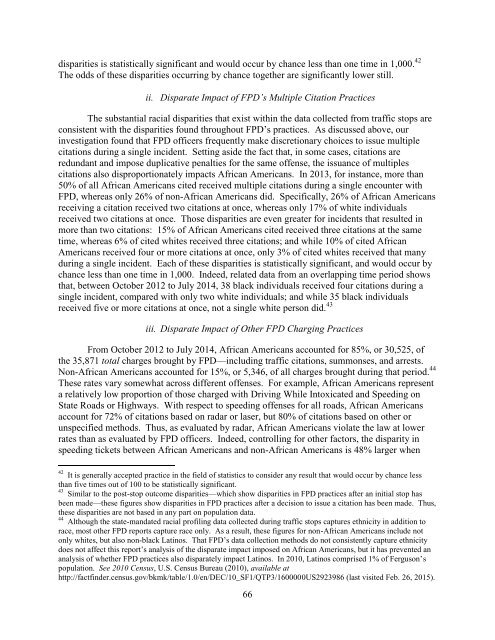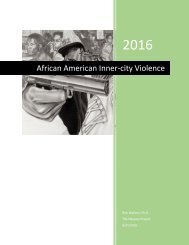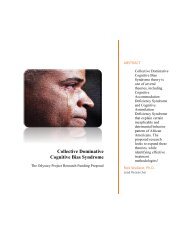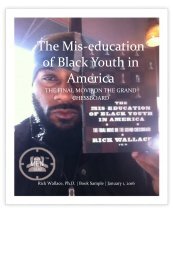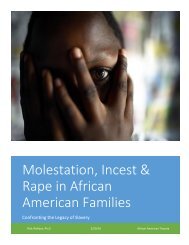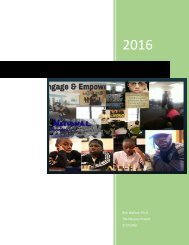U.S. Justice Department Report on the Ferguson Police Department
Ferguson’s law enforcement practices are shaped by the City’s focus on revenue rather than by public safety needs. This emphasis on revenue has compromised the institutional character of Ferguson’s police department, contributing to a pattern of unconstitutional policing, and has also shaped its municipal court, leading to procedures that raise due process concerns and inflict unnecessary harm on members of the Ferguson community.
Ferguson’s law enforcement practices are shaped by the City’s focus on revenue rather than by public safety needs. This emphasis on revenue has compromised the institutional character of Ferguson’s police department, contributing to a pattern of unconstitutional policing, and has also shaped its municipal court, leading to procedures that raise due process concerns and inflict unnecessary harm on members of the Ferguson community.
Create successful ePaper yourself
Turn your PDF publications into a flip-book with our unique Google optimized e-Paper software.
disparities is statistically significant and would occur by chance less than <strong>on</strong>e time in 1,000. 42<br />
The odds of <strong>the</strong>se disparities occurring by chance toge<strong>the</strong>r are significantly lower still.<br />
ii. Disparate Impact of FPD’s Multiple Citati<strong>on</strong> Practices<br />
The substantial racial disparities that exist within <strong>the</strong> data collected from traffic stops are<br />
c<strong>on</strong>sistent with <strong>the</strong> disparities found throughout FPD’s practices. As discussed above, our<br />
investigati<strong>on</strong> found that FPD officers frequently make discreti<strong>on</strong>ary choices to issue multiple<br />
citati<strong>on</strong>s during a single incident. Setting aside <strong>the</strong> fact that, in some cases, citati<strong>on</strong>s are<br />
redundant and impose duplicative penalties for <strong>the</strong> same offense, <strong>the</strong> issuance of multiples<br />
citati<strong>on</strong>s also disproporti<strong>on</strong>ately impacts African Americans. In 2013, for instance, more than<br />
50% of all African Americans cited received multiple citati<strong>on</strong>s during a single encounter with<br />
FPD, whereas <strong>on</strong>ly 26% of n<strong>on</strong>-African Americans did. Specifically, 26% of African Americans<br />
receiving a citati<strong>on</strong> received two citati<strong>on</strong>s at <strong>on</strong>ce, whereas <strong>on</strong>ly 17% of white individuals<br />
received two citati<strong>on</strong>s at <strong>on</strong>ce. Those disparities are even greater for incidents that resulted in<br />
more than two citati<strong>on</strong>s: 15% of African Americans cited received three citati<strong>on</strong>s at <strong>the</strong> same<br />
time, whereas 6% of cited whites received three citati<strong>on</strong>s; and while 10% of cited African<br />
Americans received four or more citati<strong>on</strong>s at <strong>on</strong>ce, <strong>on</strong>ly 3% of cited whites received that many<br />
during a single incident. Each of <strong>the</strong>se disparities is statistically significant, and would occur by<br />
chance less than <strong>on</strong>e time in 1,000. Indeed, related data from an overlapping time period shows<br />
that, between October 2012 to July 2014, 38 black individuals received four citati<strong>on</strong>s during a<br />
single incident, compared with <strong>on</strong>ly two white individuals; and while 35 black individuals<br />
received five or more citati<strong>on</strong>s at <strong>on</strong>ce, not a single white pers<strong>on</strong> did. 43<br />
iii. Disparate Impact of O<strong>the</strong>r FPD Charging Practices<br />
From October 2012 to July 2014, African Americans accounted for 85%, or 30,525, of<br />
<strong>the</strong> 35,871 total charges brought by FPD—including traffic citati<strong>on</strong>s, summ<strong>on</strong>ses, and arrests.<br />
N<strong>on</strong>-African Americans accounted for 15%, or 5,346, of all charges brought during that period. 44<br />
These rates vary somewhat across different offenses. For example, African Americans represent<br />
a relatively low proporti<strong>on</strong> of those charged with Driving While Intoxicated and Speeding <strong>on</strong><br />
State Roads or Highways. With respect to speeding offenses for all roads, African Americans<br />
account for 72% of citati<strong>on</strong>s based <strong>on</strong> radar or laser, but 80% of citati<strong>on</strong>s based <strong>on</strong> o<strong>the</strong>r or<br />
unspecified methods. Thus, as evaluated by radar, African Americans violate <strong>the</strong> law at lower<br />
rates than as evaluated by FPD officers. Indeed, c<strong>on</strong>trolling for o<strong>the</strong>r factors, <strong>the</strong> disparity in<br />
speeding tickets between African Americans and n<strong>on</strong>-African Americans is 48% larger when<br />
42 It is generally accepted practice in <strong>the</strong> field of statistics to c<strong>on</strong>sider any result that would occur by chance less<br />
than five times out of 100 to be statistically significant.<br />
43 Similar to <strong>the</strong> post-stop outcome disparities—which show disparities in FPD practices after an initial stop has<br />
been made—<strong>the</strong>se figures show disparities in FPD practices after a decisi<strong>on</strong> to issue a citati<strong>on</strong> has been made. Thus,<br />
<strong>the</strong>se disparities are not based in any part <strong>on</strong> populati<strong>on</strong> data.<br />
44 Although <strong>the</strong> state-mandated racial profiling data collected during traffic stops captures ethnicity in additi<strong>on</strong> to<br />
race, most o<strong>the</strong>r FPD reports capture race <strong>on</strong>ly. As a result, <strong>the</strong>se figures for n<strong>on</strong>-African Americans include not<br />
<strong>on</strong>ly whites, but also n<strong>on</strong>-black Latinos. That FPD’s data collecti<strong>on</strong> methods do not c<strong>on</strong>sistently capture ethnicity<br />
does not affect this report’s analysis of <strong>the</strong> disparate impact imposed <strong>on</strong> African Americans, but it has prevented an<br />
analysis of whe<strong>the</strong>r FPD practices also disparately impact Latinos. In 2010, Latinos comprised 1% of Fergus<strong>on</strong>’s<br />
populati<strong>on</strong>. See 2010 Census, U.S. Census Bureau (2010), available at<br />
http://factfinder.census.gov/bkmk/table/1.0/en/DEC/10_SF1/QTP3/1600000US2923986 (last visited Feb. 26, 2015).<br />
66


